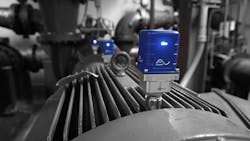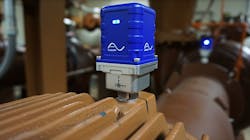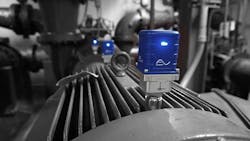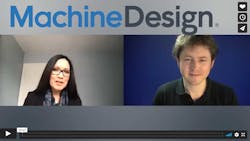AI-Based Machine Health Solutions Promise Fast Time to Value
At a Glance:
- The use of IoT technology for connecting critical assets, extracting data and improving factory operations paints a different picture today than it did five years ago.
- The pandemic and other environmental effects have caused the market to rethink the approach to supply chains.
- New business models, such as outcome-as-a-service, are on the rise.
For machine data and digital technology enthusiasts watching the rate and impact of digital adoption across industrial markets, the value of predictive analytics when it extends across physical assets and into the boardroom is well known.
What was once the domain of a select few has grown to be both a sought-after toolset and skillset. The question is no longer whether manufacturers should get on the digital bandwagon, but how soon they can invest and fully embrace a digital transformation strategy that supports a long-term vision and architecture.
“We’re now seeing that more and more companies have a clear strategy,” said Saar Yoskovitz, co-founder and CEO, Augury, an AI-based machine health solution provider that helps OEMs and service providers drive reliability and resilience. “Three years ago, we saw the birth of the chief digital officer—a new role that started with ‘let’s bring in new digital technologies, let’s bring AI, let’s bring IoT.’ Over time, we’ve seen more and more of these science projects that didn’t really go anywhere. As a result, the term ‘pilot purgatory’ has emerged.”
But that approach is changing rapidly. Organizations want to know how to solve a specific problem and how to achieve a specific outcome. The ability to deliver new forms of value has resulted in growth before and during the global health crisis, said Yoskovitz, who counts Colgate-Palmolive, Heineken, Hershey’s, Essity and ICL amongst the company’s roster of manufacturing clients.
“The moment you shift there, you have much clearer strategies—you have KPIs, you have clear expectations of what you need to achieve in each phase,” said Yoskovitz. “The ability to craft strategic plans has proven to be successful in also creating adoption and ensuring success across the whole portfolio of factories or plants within one company.”
Yoskovitz knows a thing or two about diagnostics and digital transformation. In 2011, he saw an opportunity to make full use of his degrees in electrical engineering and physics when he combined it with an entrepreneurial spirit to start up his company. He’s been invested ever since.
In a nutshell, Augury provides machine insights and prescriptive diagnostics based on the actual condition of the machine. The results can be significant reductions in planned downtime, reductions in spare parts inventories and increased productivity and margins. Augury boasts of delivering three to eight times ROI for customers in a matter of months.
“In highly stressed environments, companies want to receive payback of the annual program within three months of deployment, said Yoskovitz. “This is the most crucial piece if you are a VP of manufacturing, SVP of supply chain or director of reliability—the person who owns this new initiative. You want to see proof that you can invest more and grow the program. We’ve been highly focused on how do we provide that fast time to value, as well as how we can support adoption within organizations.”
In an interview with Machine Design, Yoskovitz shared firsthand insights about the state of manufacturing analytics and digital transformation. The abridged Q&A has been edited for context.
Machine Design: Over the past few years, geopolitics was a significant force causing manufacturers to consider supply chain options. Augury has roots in the United States and Israel, and has manufacturing ties to China. How do you see geopolitics affecting manufacturing in the near term? How will these forces play out for Augury?
Saar Yoskovitz: We work with global companies, and they don’t care if we’re in Israel or the U.S. They need us where they need us, so we’re deployed in Asia, Thailand, India, Hong Kong and Europe. We’re in eight or 10 countries—Latin America, Canada, Mexico and the U.S. And it’s not just geopolitics; we had the trade war just before the COVID-19 outbreak.
It’s also different. Pandemics or other environmental effects caused the market to rethink the approach to supply chains. In the past couple of decades, it was all about: “How do I drive efficiency in my supply chain? How do I drive out costs to offshoring in India and China? How do I drive out inventory levels in my logistics chain? All of a sudden, it is: How do we build more resiliency? How do we decouple global supply chains? How do I manage inventory levels in case there is a pandemic or a trade war? Can I react quickly? Can I be more agile? So that’s where the conversation is going.
As a result, we’re seeing much, much more investment on digitization and automation. We’re also seeing—maybe it’s recency bias due to COVID-19—more investment in remote collaboration capabilities. So, I think companies woke up to this new reality, this new normal. Post-COVID, and maybe post-trade wars, they’re looking at a much more local supply chain: How do we find local vendors of raw material? How do we decrease dependency among different countries?
I would say, from a national level, though it’s about the politics—even now, with the Biden administration—it’s understanding how important it is to invest in local manufacturing. And to me, it’s a long-term investment; it’s not just how do we build more factories, but how do we build the right foundation in our education. As an example, providing a whole new skill set to a new generation entering the market. Skills that will be required from a maintenance technician five years from now are very different from the skill set that was required 10 or 15 years ago. But our education system hasn’t adapted to that yet.
MD: One other trend that we’re following closely is the shift toward manufacturing as a service and software-as-a-service. Do you see the same impacts for large versus small- to medium-sized manufacturers?
SY: It’s an interesting trend. We’re looking at outcome as a service in general, right across the whole industry. One example we are working with is Grundfos, the largest pump manufacturer in the world. Their goal is to move from selling pumps to selling water as a service. So, how do we help create higher value services to the customer? It’s not just for supplying [products]. They’re supplying consultancy—their domain expertise—but also test how they take more ownership of the problem and provide more value to the customer. We’re seeing that across the industry.
We’re also working with Munich Re, the largest reinsurance company, on bringing new business models into the industry. One example: Last year we started guaranteeing our diagnostics. If anybody says your machine is doing well, and for whatever reason it fails, we will cover the replacement costs—both the parts and the labor.
That is just the first step; our goal is to get to upselling insurance, where we also cover any loss of capacity due to downtime, which gets into that outcome-as-a-service that you just talked about. A lot of innovation is going into the market—not just in technology, but also in new business models and creative ways of thinking about them.
Watch the Machine Design Insider Interview with Saar Yoskovitz.
About the Author

Rehana Begg
Editor-in-Chief, Machine Design
As Machine Design’s content lead, Rehana Begg is tasked with elevating the voice of the design and multi-disciplinary engineer in the face of digital transformation and engineering innovation. Begg has more than 24 years of editorial experience and has spent the past decade in the trenches of industrial manufacturing, focusing on new technologies, manufacturing innovation and business. Her B2B career has taken her from corporate boardrooms to plant floors and underground mining stopes, covering everything from automation & IIoT, robotics, mechanical design and additive manufacturing to plant operations, maintenance, reliability and continuous improvement. Begg holds an MBA, a Master of Journalism degree, and a BA (Hons.) in Political Science. She is committed to lifelong learning and feeds her passion for innovation in publishing, transparent science and clear communication by attending relevant conferences and seminars/workshops.
Follow Rehana Begg via the following social media handles:
X: @rehanabegg
LinkedIn: @rehanabegg and @MachineDesign




